Funny Humor Vs Fluid Humor Connections
"And there's the humor of it" Shakespeare and The Four Humors
William Shakespeare created characters that are among the richest and most humanly recognizable in all of literature.
Yet Shakespeare understood human personality in the terms available to his age—that of the now—discarded theory of the four bodily humors—blood, bile, melancholy, and phlegm.
These four humors were understood to define peoples' physical and mental health, and determined their personality, as well.
The language of the four humors pervades Shakespeare's plays, and their influence is felt above all in a belief that emotional states are physically determined. Carried by the bloodstream, the four humors bred the core passions of anger, grief, hope, and fear—the emotions conveyed so powerfully in Shakespeare's comedies and tragedies.
Today, neuroscientists recognize a connection between Shakespeare's age and our own in the common understanding that the emotions are based in biochemistry and that drugs can be used to alleviate mental suffering.

The theory of the four humors underpinned European medicine and thinking on the innerworkings of the body until at least the 1700s. According to humoralism, four bodily fluids—blood, yellow bile, black bile, and phlegm—determined a person's temperament and an imbalance led to certain sicknesses dependent upon which humors were in excess or deficit. The humors were connected to celestial bodies, seasons, body parts, and stages of life.
The World of Shakespeare's Humors
The four bodily humors were part of Shakespearean cosmology, inherited from the ancient Greek philosophers Aristotle, Hippocrates, and Galen.
Organized around the four elements of earth, water, air, and fire; the four qualities of cold, hot, moist, and dry; and the four humors, these physical qualities determined the behavior of all created things including the human body.
In the human body, the interaction of the four humors explained differences of age, gender, emotions, and disposition. The influence of the humors changed with the seasons and times of day and with the human life span. Heat stimulated action, cold depressed it. The young warrior's choler gave him courage, but phlegm produced cowards. Youth was hot and moist, age cold and dry. Men as a sex were hotter and drier than women.
"The mind 's inclination follows the body's temperature."

Image from Deutsche Kalendar (German Calendar), 1498
Courtesy Pierpont Morgan Library
A medieval German woodcut depicts the temperaments of the cold and dry qualities of the melancholic disposition, which were associated with old age, retentiveness, and scholarship, like the old man depicted here with his head resting on a table.

Henry Peacham," Melancolia," Minerva Britanna, 1612
Courtesy Folger Shakespeare Library

Image from Deutsche Kalendar (German Calendar), 1498
Courtesy Pierpont Morgan Library
The hot, moist man representing the sanguine temperament is depicted as an active wooer embracing a woman.
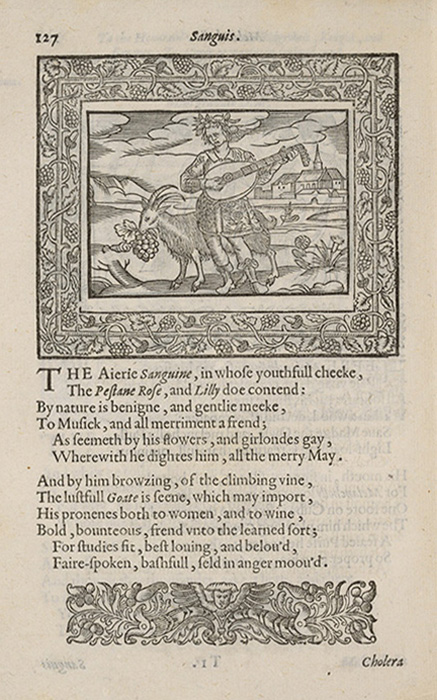
Henry Peacham, "Sanguis," Minerva Britanna, 1612
Courtesy Folger Shakespeare Library

Image from Deutsche Kalendar (German Calendar), 1498
Courtesy Pierpont Morgan Library
A cold, moist phlegmatic couple prefer retirement and leisure, signified here by music.

Henry Peacham, "Phlegma," Minerva Britanna, 1612
Courtesy Folger Shakespeare Library

Image from Deutsche Kalendar (German Calendar), 1498
Courtesy Pierpont Morgan Library
A medieval German woodcut shows a hot dry man who furiously beats the woman kneeling helplessly at his feet.

Henry Peacham, "Cholera," Minerva Britanna, 1612
Courtesy Folger Shakespeare Library

Aristotle, De Animalibus (On Animals), 1235–ca. 1245
Courtesy National Library of Medicine
Greek philosopher Aristotle (384 BCE–322 BCE) used observation to gather evidence about the biological world. He identified the classic four elements—earth, water, air, and fire—as the building blocks of the universe.

Hippocrates, Octoginta volumina, quibus maxima ex parte, annorum circiter duo milia Latina caruit lingua,… (Eighty Small Works, which for the most part have not been available in Latin for approximately two thousand years…), 1525
Courtesy National Library of Medicine
Greek physician Hippocrates (ca. 460 BCE–370 BCE) is often credited with developing the theory of the four humors—blood, yellow bile, black bile, and phlegm—and their influence on the body and its emotions.
His treatise on Airs, Waters, and Places describes the influence of geography on the body and its humoral makeup.

Galen, De temperamentis libri tres (On Temperament in Three Books), 1545
Courtesy National Library of Medicine
Born in Pergamon, Roman physician and philosopher Galen (ca. 131–ca. 201) described the four temperaments as determined by a balance of the qualities of hot, cold, moist, and dry. He was revered as a great clinician.

Thomas Walkington, Optick Glasse of Humors, 1639
Courtesy National Library of Medicine
The "glasse" in the title of University of Cambridge cleric Thomas Walkington's Optick Glasse of Humors is a mirror.The reader is promised greater self-knowledge through understanding the role of the four bodily humors in determining individual human behaviors and overall disposition. For readers of Walkington's text, "temperament" (what we would call personality) was literally a matter of temperature—the result of the action of cold, hot, wet, and dry in governing behavior.
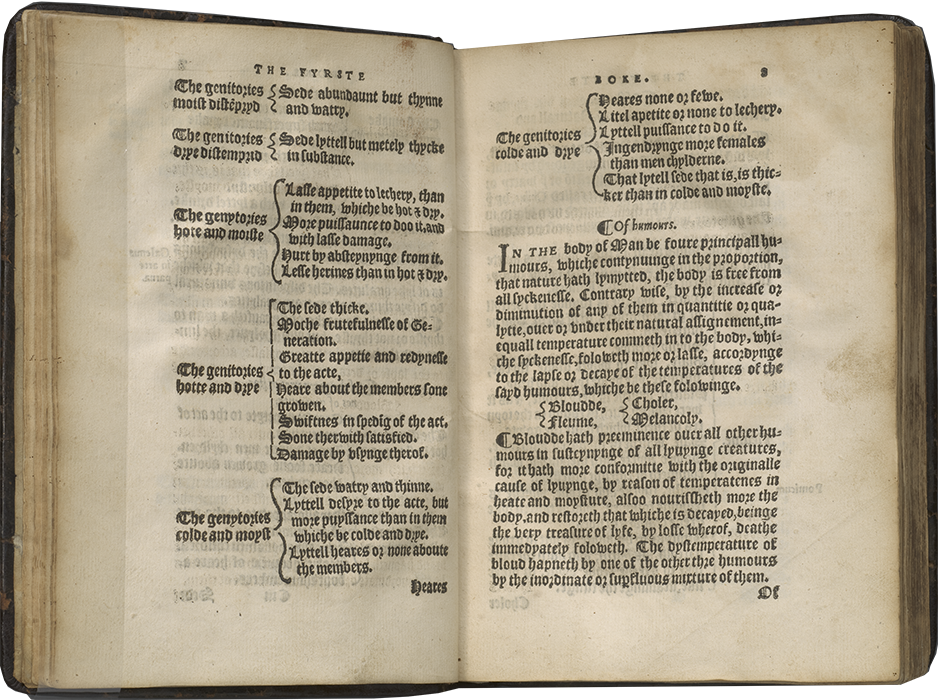
Thomas Elyot, Castel of Helth, 1541
Courtesy National Library of Medicine
Tudor humanist Thomas Elyot (1490–1546) writes The Castel of Helth as an accessible introduction to the basic concepts of ancient Greek and Roman medicine. Here he describes sickness as an imbalance—or distemperature—in the quantity or quality of one of the four bodily humors. Blood has "preeminence" over the other humors because it was in the blood that melancholy, phlegm, and choler were delivered to the other parts of the body.
The Unruly Woman: The case of Katharine Minola
The Taming of the Shrew
Shakespeare depicts the full range of humoralism in his dramatic characters. An excess of the hot, dry emotion of choler, or yellow bile, produced an angry disposition. Choler is valuable in great warriors but in the domestic world of romantic comedy, anger—especially the anger of women—represents a social problem for Shakespeare's age, which calls for strong therapeutic intervention.
How to manage female anger is the central question of The Taming of the Shrew. Both protagonists, Kate and Petruchio, are identified as choleric by nature, and his behavior in the play is widely seen as eccentric and disruptive. Yet, it becomes Petruchio's job as husband to tame his shrewish wife and make her "a Kate conformable as other household Kates."
"I 'll curb her mad and headstrong humor."
The Taming of the Shrew

David Bogue, Angry face of Katharine Minola, 1847
Courtesy Folger Shakespeare Library
In an era when women were enjoined to be silent and obedient, Katharine Minola is an outspoken, angry young woman—a "shrew" in Elizabethan parlance. Kate is hurt by her father's clear preference for her younger sister, the pliant Bianca, and by his desire to marry her off as quickly as possible.

Louis Rhead, Petruchio bears off his bride, ca. 1918
Courtesy Folger Shakespeare Library
Petruchio's taming of Kate begins with his disorderly behavior at their wedding when he arrives late and poorly dressed and interrupts the wedding feast by dragging her off to his home far away.

William Shakespeare, The Taming of the Shrew, Quarto, 1631
Courtesy Folger Shakespeare Library
Petruchio's harsh program of "taming" his bride is a calculated intervention in her living conditions. He intends to change her humor by removing the accumulation of hot, dry choler in her body.

Louis Rhead, Petruchio entertains his wife at dinner, ca. 1918
Courtesy Folger Shakespeare Library
Petruchio denies his wife dinner, claiming that roasted meat is too hot and dry for her nature. He deprives her of the pleasure of new clothes and of female companionship. All these deprivations have the effect of wearing her out, both physically and emotionally, until by the end of the play she is willing to submit to his humor, no matter what it might be.
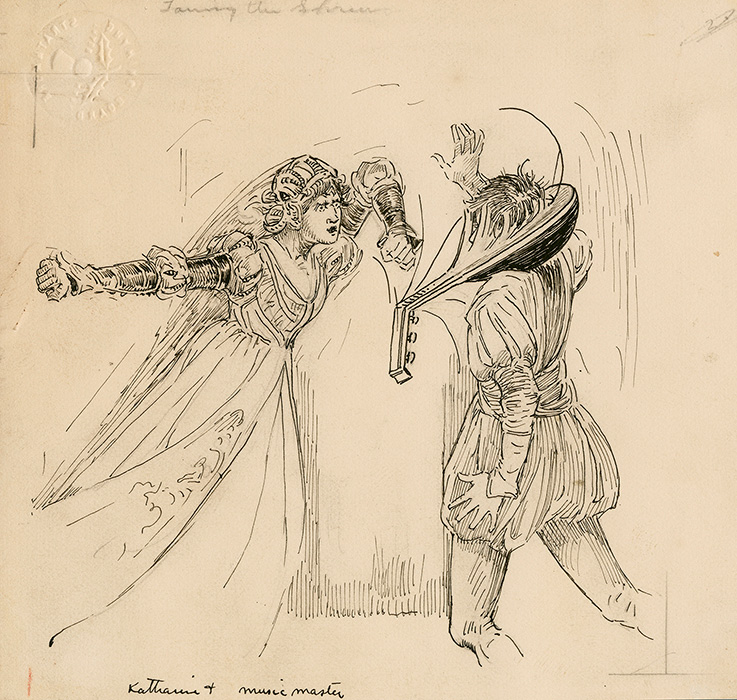
Louis Rhead, Katharine and music master, ca.1918
Courtesy Folger Shakespeare Library
Here, in a scene described in Shakespeare's play, Katharine refuses to accept the music lessons that early modern affluent families would have deemed appropriate for female instruction and socialization in the domestic arts.
Melancholy Virgins: The Case of Ophelia
The Tragedy of Hamlet, Prince of Denmark
"They are apt to loathe, dislike, disdaine, to be weary of every object, each thing almost is odious to them, they pine away, void of counsel, apt to weep and tremble, timorous, fearful, sad, and out of all hopes of better fortunes."
Robert Burton
Anatomy of Melancholy, 1632
Melancholy is the most complex of emotions for Shakespeare and his contemporaries, as it was for the ancients. The cold, dry temperament was considered the least desirable of the four, yet melancholy was also traditionally associated with genius and the life of scholarship.
In Hamlet, Ophelia becomes a classic case of the melancholy virgin because of her isolation at court, her overbearing father's commands, and Hamlet's withdrawal of attention from her.
"They are apt to loathe, dislike, disdaine, to be weary of every object, each thing almost is odious to them, they pine away, void of counsel, apt to weep and tremble, timorous, fearful, sad, and out of all hopes of better fortunes."
The Tragedy of Hamlet

John Hayter, Melancholy face of Ophelia,1846
Courtesy Folger Shakespeare Library

Anonymous, Ophelia in Hamlet, late 19th–early 20th century
Courtesy Folger Shakespeare Library
William Shakespeare's audiences would have understood the madness to which Ophelia succumbs after being cast out by Hamlet as an overheating of the brain resulting directly from her social circumstances.
Note her slumped posture and downward gaze. Instead of looking after the departing Hamlet, who has just angrily ordered her to "get thee to a nunnery," she looks at the floor sadly.

William Shakespeare, Hamlet, Quarto, 1637
Courtesy Folger Shakespeare Library
The pathos of Ophelia's situation is clear even before her father's murder at Hamlet's hands. Lacking activity and the hopeful future symbolized by marriage, Ophelia succumbs to despair and eventually madness.
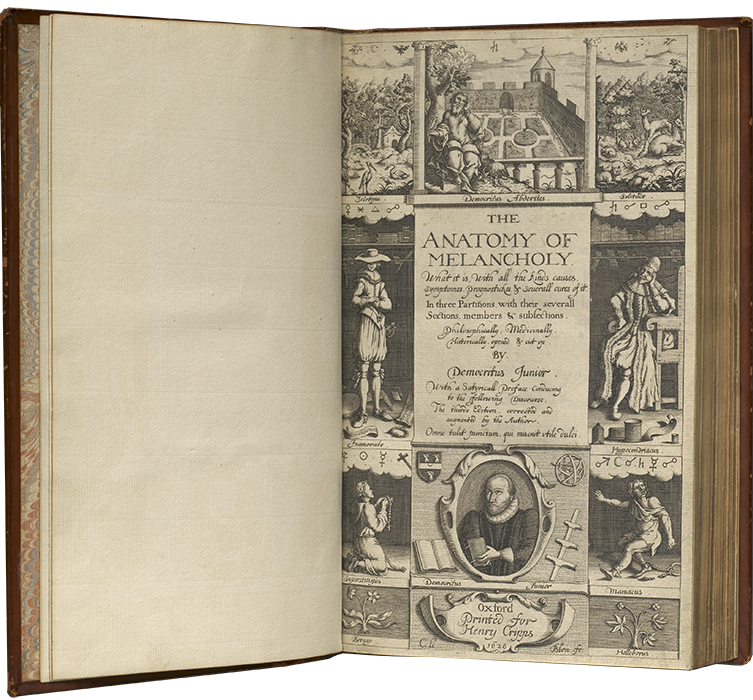
Robert Burton, Anatomy of Melancholy, 1628
Courtesy National Library of Medicine
English Renaissance cleric and scholar Robert Burton (1577–1640), who wrote about the different types of melancholy, described the female melancholic—represented by virgins and widows—as special cases. According to Burton, unmarried gentlewomen with little to do are afflicted with a "torrent of inward humours." Above all, they lack the social purpose conferred only by marriage.

Rembert Dodoens, A Niewe Herball, 1578
Courtesy National Library of Medicine
The healing powers of violets described by Flemish physician and botanist Rembert Dodoens (1517–1585) were well known to Shakespeare's contemporaries. Madness of the kind Ophelia suffers after her father's death and Hamlet's rejection of her would have been understood as a drying and overheating of the brain. The cooling properties of violets and their sweet scent—what we would call aromatherapy—would have been prescribed in her case. But there is no one in the Danish court to befriend and care for Ophelia. So it is ironic when in her madness she distributes flowers to the court and tells them, "I would give you some violets, but they withered all when my father died."
Melancholy in Age: The Case of Shylock
The Merchant of Venice
For William Shakespeare and his contemporaries, aging was a process of gradual drying of the flesh and cooling of bodily humors. The body's supply of blood diminished as individuals approached the final coldness and dryness of death. In old age, the body developed an excess of melancholy and the sad, unforgiving, and close-fisted disposition that accompanied that retentive bodily humor.
In The Merchant of Venice, Shylock is reviled by anti-Semitic Venetians who might have seen him as a pathological case of unnatural melancholy or "melancholy adust." When the body's natural heat and moisture were burned up by vengefulness like Shylock's against his Venetian enemies, the naturally clear fluids of the brain became darkened, resulting in an excess of the melancholy humor and what we might recognize as depression and unresolved anger.
"Do as I bid you. Shut doors after you./ Fast bind, fast find—/ A proverb never stale in thrifty mind."
The Merchant of Venice

Felix Darley, Shylock and Jessica, 1885
Courtesy Folger Shakespeare Library
Cautioning daughter Jessica to lock up his doors as he goes out unwillingly to a feast, Shylock displays the retentiveness and lack of sociality associated with the cold, dry temperament.
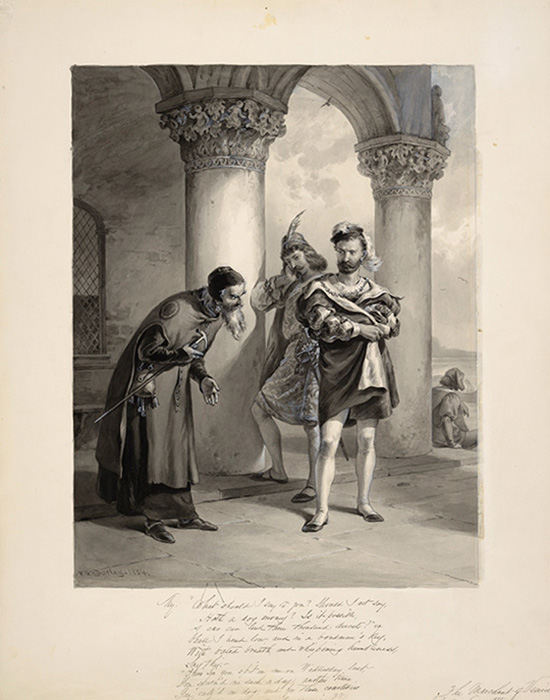
Felix Darley, Shylock with Antonio and Bassanio, 1884
William Shakespeare's contemporaries would have identified Shylock's traits—his occupation as moneylender, his calculating disposition, his suspiciousness of others, his long memory, and his cruelty in demanding a pound of flesh from the merchant Antonio as repayment of a debt—as a melancholic.

William Shakespeare, The Merchant of Venice, ca. 1598
Courtesy Folger Shakespeare Library
The publication of inexpensive editions of Shakespeare's plays, like this ca. 1598 quarto of The Merchant of Venice, suggests that there was an audience of readers as well as theatre goers interested in Shylock and Shakespeare's Venice.

Robert Burton, Anatomy of Melancholy, 1624
Courtesy National Library of Medicine
Renaissance culture generally associated old age with melancholy. English scholar Robert Burton wrote "Old age, being cold and dry, and of the same quality as melancholy is, must needs cause it, by diminution of spirits and substance."
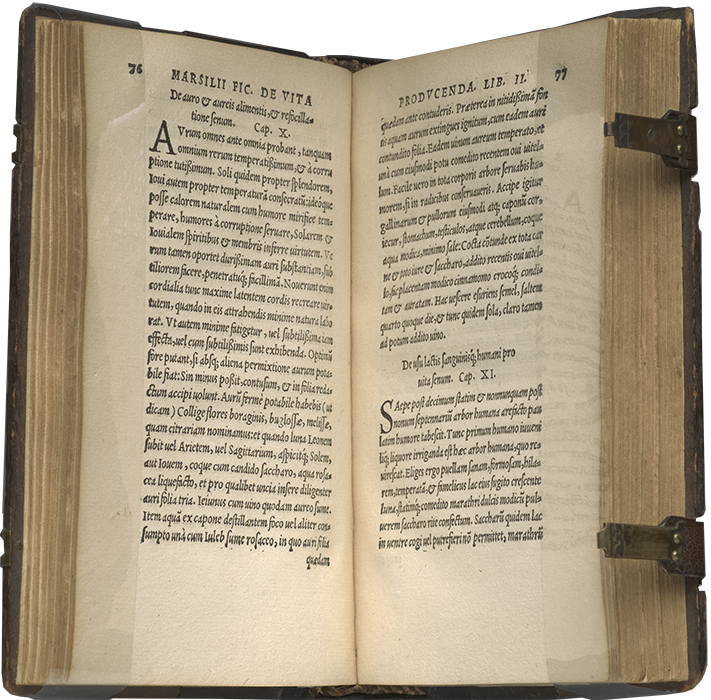
Marsilio Ficino, De vita libri tres (Three Books on Life), 1529
Courtesy National Library of Medicine
The Italian philosopher Marsilio Ficino (1433–1499), himself a melancholic by birth, was interested in warm, moistening therapies to prolong life and counteract the cold dryness of old age.
In his De vita libri tres (Three Books on Life), he recommends that old people drink the warm milk of a young woman "who is healthy, beautiful, temperate, and cheerful." He would have the elderly take spicy cordials to keep them "in a state of natural greenness" and walk among green fields because "a certain youthful spirit flows to us through the odor, sight, use, and habitation of and in them."
Source: https://www.nlm.nih.gov/exhibition/shakespeare-and-the-four-humors/index.html
0 Response to "Funny Humor Vs Fluid Humor Connections"
Post a Comment